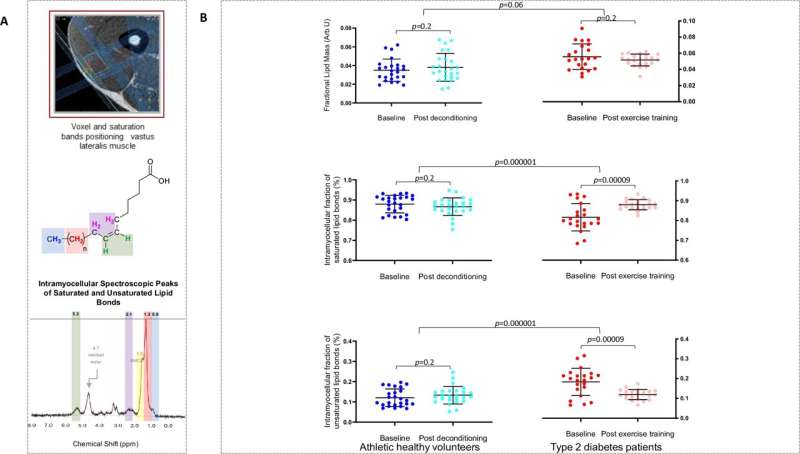Volunteers rode exercise bikes as part of the trial. Credit: University of Aberdeen
An active lifestyle can change how the body burns saturated and unsaturated fat according to new research from the University of Aberdeen.
In the study, published in Nature Communicationsresearchers investigated how different types of fat are used by the body, depending on the individual’s level of physical fitness.
While this study did not look at diet, which is notoriously difficult to control, it examined how fat is metabolized. The researchers analyzed the effects in two groups—”super healthy” male athletes and males with type 2 diabetes who did little to no exercise.
Both groups swapped exercise regimes for eight weeks.
The athletes underwent “deconditioning” where they went from exercising vigorously for at least nine and a half hours per week to none. In contrast, the people with type 2 diabetes underwent endurance training where they exercised for five hours a week.
Before and after the lifestyle swap, the volunteers received small amounts of different fats via an intravenous injection and had MRI scans to see how the fat behaved inside their muscle cells.
Results showed the group with type 2 diabetes lost weight, improved their insulin sensitivity and lowered their cholesterol, triglycerides and fasting glucose levels.
The team, led by Professor Dana Dawson, also found that in athletes, saturated fat is used intensely for physical activity as the “preferred source of energy.”
“We discovered that athletes store and utilize saturated fat intensely for high performance physical activity and conversely in people with type 2 diabetes, we observed predominantly storage,” said Professor Dawson, Chair in Cardiovascular Medicine at the University.
“We also showed in people with type 2 diabetes that endurance exercise training increased the storage and utilization of saturated fat in their skeletal muscle cells to the extent that they became similar to the deconditioned athletes after 8 weeks of training.
“Overall, the most striking and completely new perspective we have taken from this study is that one size ‘doesn’t fit all’ and that one’s cardio-metabolic health dictates how efficiently you’re able to use different fats as fuel.
“These results are completely novel and highlight how keeping fit and active improves metabolism of saturated fat as a direct benefit of exercise.”

Professor Bryan Williams, chief scientific and medical officer at the British Heart Foundation, said, “This small study reinforces the benefits of keeping active on our heart health. While the study compared two very specific groups—male athletes and men with type 2 diabetes— The findings offer reassurance that being physically active can improve how the body uses different types of fat.
“Importantly, the study did not assess the impact of consuming fat, and the existing advice remains to try and replace saturated fat in the diet with unsaturated fat.
“Daily physical activity can reduce the risk of cardiovascular disease by lowering cholesterol, triglycerides and fasting blood sugar levels, as well as helping to maintain a healthy weight. When it comes to being active, it’s important to get into a routine that you enjoy and That you can stick to. Try to build up to 150 minutes of moderate intensity activity a week, such as a brisk walk, swimming or cycling.”
More information:
Alice M. Mezincescu et al, Comparison of intramyocellular lipid metabolism in patients with diabetes and male athletes, Nature Communications (2024). DOI: 10.1038/s41467-024-47843-y
Citation: Consistent exercise changes how saturated fat is used by the body, study finds (2024, May 16) retrieved 16 May 2024 from
This document is subject to copyright. Apart from any fair dealing for the purpose of private study or research, no part may be reproduced without the written permission. The content is provided for information purposes only.
